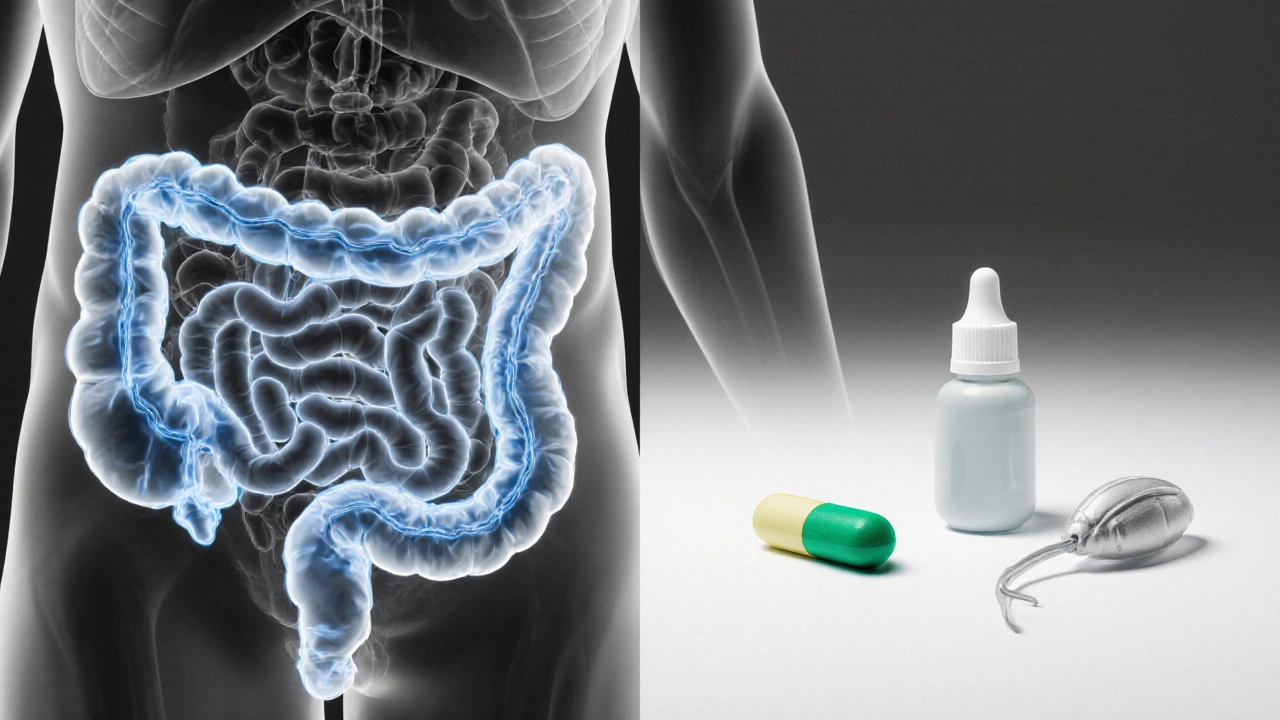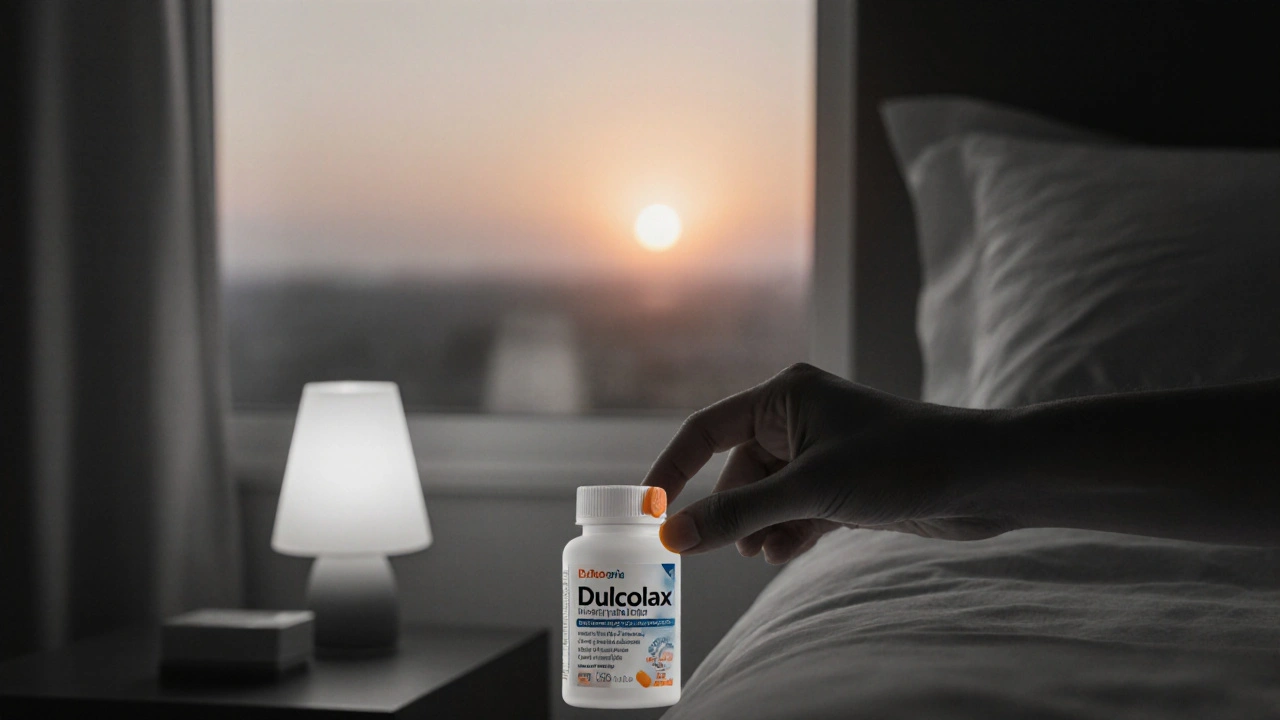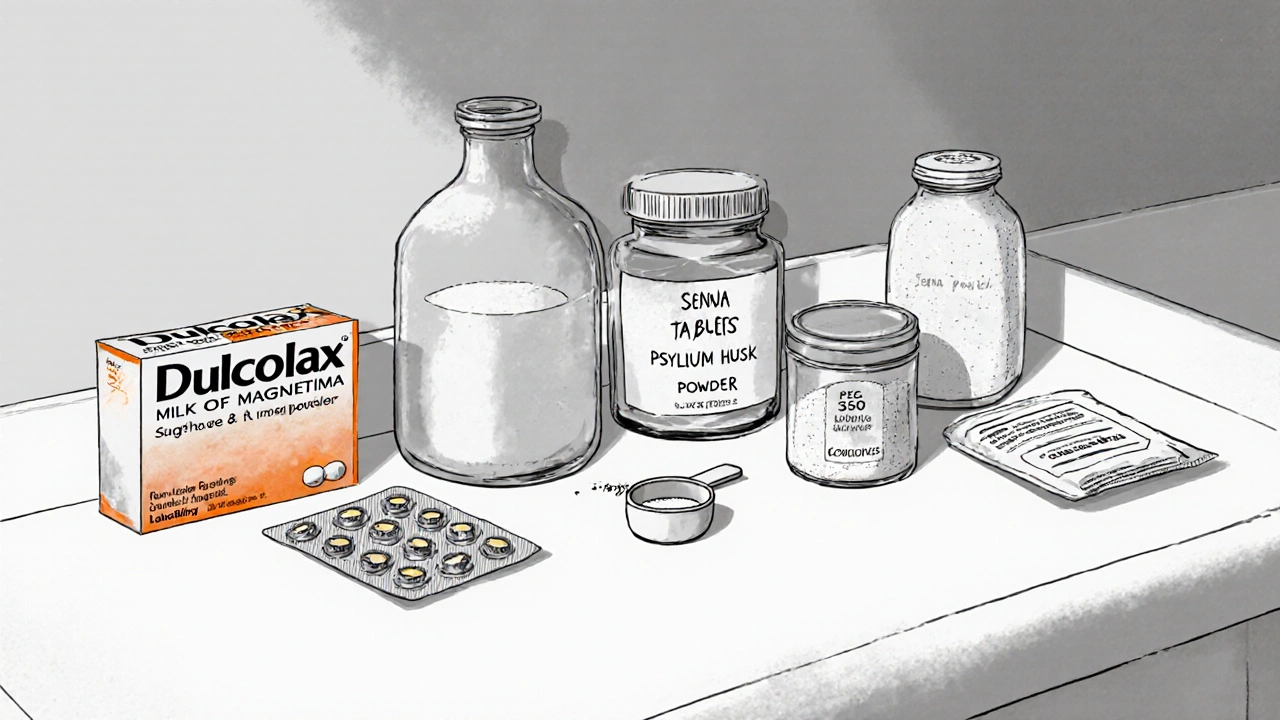Laxative Selection Tool
Find the Right Laxative for You
Select your criteria to see which over-the-counter laxatives best match your needs and circumstances.
1. What's your primary need?
2. Any health considerations?
3. Preferred mechanism type
Recommended Options
Based on your selections, these laxatives are most appropriate for your situation.
When constipation strikes, the first instinct is often to reach for an over‑the‑counter solution. Dulcolax (the brand name for bisacodyl) is one of the most popular choices, but it’s far from the only option. This guide walks you through how Dulcolax stacks up against the most common alternatives, so you can pick the right remedy for your body and your schedule.
Quick Takeaways
- Dulcolax works as a stimulant laxative, kicking in within 6-12hours.
- Fiber‑based options like psyllium are gentler but need daily use.
- Osmotic agents (PEG 3350, magnesium hydroxide) are fast‑acting and suitable for longer‑term use.
- Choose a form (tablet, suppository, liquid) that fits your comfort level.
- Consider side‑effects, drug interactions, and any underlying health conditions before deciding.
Understanding Dulcolax (Bisacodyl)
Dulcolax is a stimulant laxative containing the active ingredient bisacodyl. It works by stimulating intestinal muscle contractions, helping stool move through the colon more quickly. Available as oral tablets, suppositories, and a liquid formulation, Dulcolax is typically taken at bedtime for a next‑morning result.
How Other OTC Laxatives Differ
Below are the most widely used alternatives, each with its own mechanism and usage profile.
Senna is a plant‑derived stimulant laxative that irritates the colon lining to promote bowel movements. It’s sold under brand names like Ex-Lax and generic tablets.
Milk of Magnesia (magnesium hydroxide) is an osmotic laxative that draws water into the intestines, softening stool.
Psyllium Husk is a soluble fiber supplement that expands in the gut to add bulk and stimulate peristalsis. Common brands include Metamucil.
PEG 3350 (MiraLAX) is an osmotic laxative polymer that retains water in the stool, making it easier to pass. It’s sold as a powder that mixes with water.
Lactulose is a synthetic sugar osmotic laxative that is fermented by gut bacteria, producing acids that pull water into the colon.
Glycerin Suppositories are rectal laxatives that soften stool by attracting water, providing rapid relief within minutes.
Side‑Effect Profile at a Glance
- Dulcolax: Cramping, urgency, possible electrolyte shift with prolonged use.
- Senna: Similar cramping; risk of dependence if used daily for weeks.
- Milk of Magnesia: Diarrhea, occasional gas; safe for short‑term use.
- Psyllium: Bloating if not taken with enough water; generally well‑tolerated.
- PEG 3350: Minimal cramping, mild nausea; safe for long‑term.
- Lactulose: Flatulence, occasional abdominal discomfort.
- Glycerin Suppositories: Minimal systemic side‑effects; localized irritation possible.

Comparison Table
| Product | Mechanism | Typical Onset | Form(s) | Best Use Case | Common Side‑Effects |
|---|---|---|---|---|---|
| Dulcolax (Bisacodyl) | Stimulant | 6-12hrs | Tablets, Suppository, Liquid | Quick relief, occasional constipation | Abdominal cramping, urgency |
| Senna | Stimulant (plant‑based) | 6-12hrs | Tablets, Liquid | Short‑term relief, travel | Cramping, dependence risk |
| Milk of Magnesia | Osmotic (magnesium hydroxide) | 30min-2hrs | Liquid | Fast relief, occasional constipation | Diarrhea, gas |
| Psyllium Husk | Bulk‑forming fiber | 12-24hrs (with daily use) | Powder, Capsules | Chronic constipation, regular bowel health | Bloating, need for adequate water |
| PEG 3350 (MiraLAX) | Osmotic polymer | 1-3days (with regular dosing) | Powder | Long‑term management, IBS‑C | mild nausea, rarely electrolyte imbalance |
| Lactulose | Osmotic sugar | 24-48hrs | Liquid | Chronic constipation, hepatic encephalopathy | Flatulence, abdominal discomfort |
| Glycerin Suppositories | Rectal hygroscopic agent | 5-15min | Suppository | Immediate relief, hemorrhoid‑related blockage | Local irritation, rarely allergic reaction |
Choosing the Right Option for You
Here’s a quick decision flow you can follow:
- If you need immediate relief (under an hour), consider a glycerin suppository or a liquid magnesium hydroxide (Milk of Magnesia).
- If you prefer a night‑time solution that works by morning, Dulcolax or Senna tablets are solid choices.
- For gentler, daily maintenance, fiber supplements like psyllium or osmotic powders such as PEG3350 are better.
- When you have underlying health issues (e.g., renal disease, heart failure), avoid high‑sodium or high‑magnesium products and talk to a pharmacist.
Potential Drug Interactions and Precautions
Stimulant laxatives (Dulcolax, Senna) can speed up gut transit enough to reduce absorption of certain medications, such as digoxin or oral contraceptives. Always space those drugs at least 2hours apart. Osmotic agents (PEG3350, lactulose) may affect electrolyte levels if used excessively, which is a concern for patients on diuretics or with heart disease.

When to Seek Medical Advice
- Symptoms persist longer than 2weeks despite OTC use.
- Accompanied by severe abdominal pain, vomiting, or blood in stool.
- Underlying conditions like diabetes, hypothyroidism, or inflammatory bowel disease.
- Pregnant or breastfeeding individuals should consult a healthcare professional before regular laxative use.
Frequently Asked Questions
Can I use Dulcolax every day?
Occasional use is fine, but daily use can lead to dependence and electrolyte imbalance. For chronic constipation, fiber or osmotic agents are safer long‑term options.
How does Dulcolax differ from Senna?
Both are stimulants, but Dulcolax’s active ingredient bisacodyl is a synthetic diphenylmethane, while Senna derives its active anthraquinones from the plant. Their onset times are similar; however, some users report milder cramping with Dulcolax.
Is PEG3350 safe for long‑term use?
Yes, PEG3350 (MiraLAX) is FDA‑approved for chronic constipation and is considered safe for extended use when taken as directed. Monitoring electrolytes is still advisable for people on certain meds.
Can I take a fiber supplement and Dulcolax together?
Yes, combining a bulk‑forming fiber (like psyllium) with an occasional stimulant can improve effectiveness, but be sure to drink plenty of water to avoid blockage.
What should I do if I experience severe cramping after taking Dulcolax?
Stop the medication and hydrate with electrolytes. If cramping lasts more than a few hours or is accompanied by vomiting or fever, seek medical attention.
Bottom Line
Choosing a laxative isn’t a one‑size‑fits‑all decision. Dulcolax offers a fast, reliable kick for occasional constipation, but it can cause cramping and isn’t ideal for everyday use. Alternatives like psyllium provide gentle, sustainable relief, while osmotic agents such as PEG3350 deliver consistent results with fewer side‑effects.
Assess your timing needs, how often you face constipation, and any health constraints before settling on a product. When in doubt, a quick chat with a pharmacist can fine‑tune the choice to your personal health profile.

Roger Perez
October 15, 2025 AT 18:15Constipation is a reminder that our bodies crave balance, and the arsenal of OTC options offers a fascinating toolbox.
The Dulcolax, with its bisacodyl core, acts like a gentle alarm clock for the colon, triggering coordinated muscle contractions.
The 6‑12 hour window aligns well with a bedtime dose, so you can wake up with a sense of relief and optimism. 😊
In comparison, fiber supplements such as psyllium whisper to the gut, adding bulk over days rather than delivering an immediate jolt.
Osmotic agents like magnesium hydroxide and PEG 3350, meanwhile, draw water into the lumen, softening stool in a more gradual, sustainable fashion.
When you consider pharmacodynamics, the stimulant class can accelerate transit but also risk electrolyte shifts if overused.
This is why clinicians advise limiting Dulcolax to occasional use, reserving daily regimens for fiber or osmotic solutions.
A practical tip: stay well‑hydrated when pairing any bulk‑forming agent with a stimulant-water is the silent hero of bowel health.
For those with renal concerns, magnesium‑based products may accumulate, so a sodium‑free fiber approach is often wiser.
The decision matrix also includes personal schedule: a night‑time tablet fits a busy morning, while a glycerin suppository saves the day in emergencies.
From a philosophical angle, each choice reflects a trade‑off between immediacy and gentleness, short‑term comfort versus long‑term equilibrium.
The key is listening to your body’s signals-cramping may signal you’ve pushed too hard, whereas mild urgency is a welcome nudge.
If you experience severe abdominal pain, it’s a cue to pause and consult a healthcare professional.
Remember, the gut microbiome also plays a role; chronic reliance on stimulants can alter bacterial composition over time.
Therefore, a rotational strategy-alternating fiber, osmotic, and occasional stimulant-can preserve both function and microbial harmony.
Ultimately, the best OTC laxative is the one that aligns with your health goals, timing needs, and safety profile. 🌟
michael santoso
October 30, 2025 AT 04:28One must acknowledge the inherent hierarchy within laxative pharmacology.
The stimulant class, epitomized by bisacodyl, is often lauded for its rapidity yet remains a blunt instrument compared to the nuanced osmolality of PEG formulations.
Moreover, the indiscriminate marketing of Dulcolax sidesteps rigorous discourse on long‑term colonic tone alteration.
It is incumbent upon the discerning consumer to interrogate such simplifications rather than accept them at face value.
Ultimately, the market’s preference for immediacy betrays a deeper neglect of physiological stewardship.
M2lifestyle Prem nagar
November 13, 2025 AT 15:41Hydration is essential when using fiber supplements to prevent secondary blockage.
Karen Ballard
November 28, 2025 AT 02:55Absolutely, proper hydration is the cornerstone of any fiber regimen. 😊
Without sufficient fluid, psyllium can actually exacerbate constipation rather than alleviate it.
I always recommend at least eight glasses of water a day when incorporating bulk‑forming agents.
This simple habit dramatically improves both comfort and efficacy.
Gina Lola
December 12, 2025 AT 14:08When dissecting the pharmacokinetic profile, Dulcolax’s bisacodyl exhibits a rapid first‑pass metabolism that translates to a sharp surge in colonic motility.
Contrast that with the osmotic gradient generated by magnesium hydroxide, which leverages colonic water influx via passive diffusion.
From a therapeutic index standpoint, the stimulant’s narrow safety window warrants cautious titration, especially in patients with compromised electrolyte reserves.
Meanwhile, PEG 3350, as a high‑molecular‑weight polymer, offers a controlled osmotic load with minimal systemic absorption, making it a preferred option for chronic management.
Bottom line: the choice hinges on the interplay between desired onset, safety profile, and patient adherence.